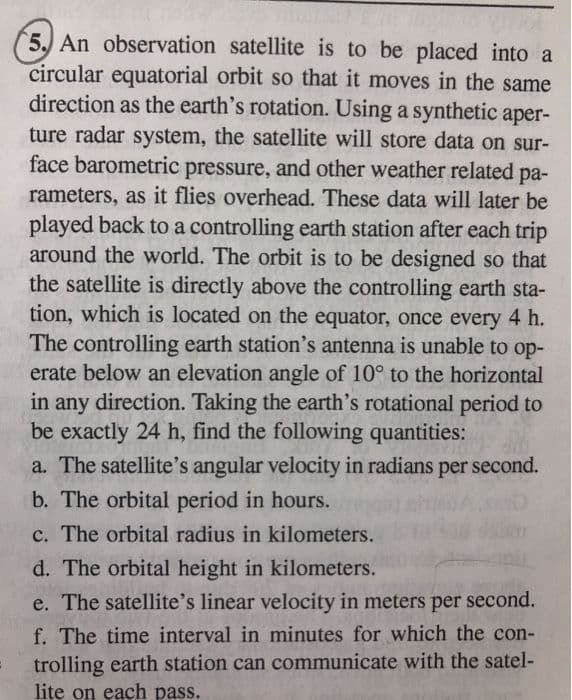5.) An observation satellite is to be placed into a circular equatorial orbit so that it moves in the same direction as the earth's rotation. Using a synthetic aper- ture radar system, the satellite will store data on sur- face barometric pressure, and other weather related pa- rameters, as it flies overhead. These data will later be played back to a controlling earth station after each trip around the world. The orbit is to be designed so that the satellite is directly above the controlling earth sta- tion, which is located on the equator, once every 4 h. The controlling earth station's antenna is unable to op- erate below an elevation angle of 10° to the horizontal direction. Taking the earth's rotational period to in any be exactly 24 h, find the following quantities: a. The satellite's angular velocity in radians per second. b. The orbital period in hours. c. The orbital radius in kilometers.
5.) An observation satellite is to be placed into a circular equatorial orbit so that it moves in the same direction as the earth's rotation. Using a synthetic aper- ture radar system, the satellite will store data on sur- face barometric pressure, and other weather related pa- rameters, as it flies overhead. These data will later be played back to a controlling earth station after each trip around the world. The orbit is to be designed so that the satellite is directly above the controlling earth sta- tion, which is located on the equator, once every 4 h. The controlling earth station's antenna is unable to op- erate below an elevation angle of 10° to the horizontal direction. Taking the earth's rotational period to in any be exactly 24 h, find the following quantities: a. The satellite's angular velocity in radians per second. b. The orbital period in hours. c. The orbital radius in kilometers.
Introductory Circuit Analysis (13th Edition)
13th Edition
ISBN:9780133923605
Author:Robert L. Boylestad
Publisher:Robert L. Boylestad
Chapter1: Introduction
Section: Chapter Questions
Problem 1P: Visit your local library (at school or home) and describe the extent to which it provides literature...
Related questions
Question
I need the answer quickly

Transcribed Image Text:5. An observation satellite is to be placed into a
circular equatorial orbit so that it moves in the same
direction as the earth's rotation. Using a synthetic aper-
ture radar system, the satellite will store data on sur-
face barometric pressure, and other weather related pa-
ра-
rameters, as it flies overhead. These data will later be
played back to a controlling earth station after each trip
around the world. The orbit is to be designed so that
the satellite is directly above the controlling earth sta-
tion, which is located on the equator, once every 4 h.
The controlling earth station's antenna is unable to op-
erate below an elevation angle of 10° to the horizontal
in any direction. Taking the earth's rotational period to
be exactly 24 h, find the following quantities:
a. The satellite's angular velocity in radians per second.
b. The orbital period in hours.
c. The orbital radius in kilometers.
d. The orbital height in kilometers.
e. The satellite's linear velocity in meters per second.
f. The time interval in minutes for which the con-
trolling earth station can communicate with the satel-
lite on each pass.
Expert Solution
This question has been solved!
Explore an expertly crafted, step-by-step solution for a thorough understanding of key concepts.
This is a popular solution!
Trending now
This is a popular solution!
Step by step
Solved in 2 steps

Recommended textbooks for you

Introductory Circuit Analysis (13th Edition)
Electrical Engineering
ISBN:
9780133923605
Author:
Robert L. Boylestad
Publisher:
PEARSON

Delmar's Standard Textbook Of Electricity
Electrical Engineering
ISBN:
9781337900348
Author:
Stephen L. Herman
Publisher:
Cengage Learning

Programmable Logic Controllers
Electrical Engineering
ISBN:
9780073373843
Author:
Frank D. Petruzella
Publisher:
McGraw-Hill Education

Introductory Circuit Analysis (13th Edition)
Electrical Engineering
ISBN:
9780133923605
Author:
Robert L. Boylestad
Publisher:
PEARSON

Delmar's Standard Textbook Of Electricity
Electrical Engineering
ISBN:
9781337900348
Author:
Stephen L. Herman
Publisher:
Cengage Learning

Programmable Logic Controllers
Electrical Engineering
ISBN:
9780073373843
Author:
Frank D. Petruzella
Publisher:
McGraw-Hill Education

Fundamentals of Electric Circuits
Electrical Engineering
ISBN:
9780078028229
Author:
Charles K Alexander, Matthew Sadiku
Publisher:
McGraw-Hill Education

Electric Circuits. (11th Edition)
Electrical Engineering
ISBN:
9780134746968
Author:
James W. Nilsson, Susan Riedel
Publisher:
PEARSON

Engineering Electromagnetics
Electrical Engineering
ISBN:
9780078028151
Author:
Hayt, William H. (william Hart), Jr, BUCK, John A.
Publisher:
Mcgraw-hill Education,